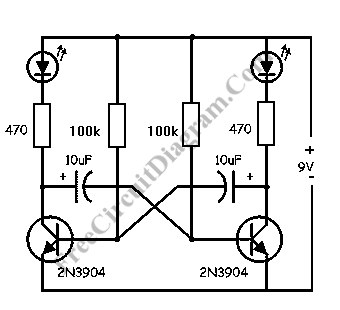
LED Flasher Circuit Using Transistors

This LED flasher circuit is a classic two-transistor flip-flop. It is a popular circuit often built by beginners in electronic circuit design. The schematic diagram of this well-known LED flasher circuit consists of two transistors, two capacitors, four resistors, and two LEDs. When the power supply is first connected, both transistors compete to be triggered first by the base current flowing through a 100k resistor. The first transistor that is triggered behaves like a closed switch, turning on the LED, while the base of the other transistor is grounded through a capacitor. This grounding keeps the first transistor activated and the second one off until the capacitor charges above the bias voltage required to activate the second transistor. Once this voltage is reached, the second transistor is switched on, activating the LED connected to its collector and turning off the first transistor by grounding its base through the second capacitor. This alternating process continues indefinitely until the power supply is disconnected. The flashing rate is determined by the values of the resistors (100k) and capacitors. Adjusting the capacitor values can change the flashing frequency; a higher capacitance results in a lower flashing rate, and vice versa. This LED flasher circuit can be used for various decorative purposes, such as Christmas decorations or Halloween Jack-O-Lanterns, as well as practical applications like turn signals for model cars or safety flashers for bicycles. The versatility of this LED flasher circuit allows for a wide range of creative uses.
The LED flasher circuit operates on the principle of a bistable multivibrator, utilizing two NPN transistors, commonly 2N3904 or similar, configured in a feedback loop. Each transistor's collector is connected to a respective LED, which is in turn connected to the positive voltage supply. The base of each transistor is connected to the collector of the opposite transistor through a resistor and capacitor, creating a feedback mechanism that allows one transistor to turn off the other.
In the initial state, when power is applied, one of the transistors will turn on due to slight variations in the circuit or component tolerances. This transistor will pull its collector low, turning on its associated LED. The charged capacitor connected to the base of the second transistor will then discharge, keeping it off momentarily. As the capacitor discharges, it will eventually reach a voltage level that turns on the second transistor, which will then turn off the first transistor by grounding its base. This cycle continues, causing the LEDs to flash alternately.
The flash rate of the circuit can be fine-tuned by varying the resistor values and capacitor capacitance. A standard configuration might employ two 100k ohm resistors and two capacitors ranging from 10µF to 100µF. Lowering the resistance or increasing the capacitance will result in a slower flash rate, making it suitable for applications requiring a more pronounced visual effect.
The circuit can be powered by a low-voltage DC supply, such as a 9V battery or a regulated power supply. For practical implementation, it is essential to ensure that the transistors are adequately heat-sinked if the circuit is operated at higher currents, particularly when driving higher-power LEDs.
Overall, this LED flasher circuit serves as an excellent introduction to basic electronic principles, including feedback, timing, and the operation of transistors, making it a valuable project for both novice and experienced electronics enthusiasts.This LED flasher circuit is a classic two transistor flip flop. This flasher circuit is very popular and it`s usually the first circuit to build when starting electronic circuit building hobby. Here is the schematic diagram of the famous LED flasher circuit: The circuit consist of two transistors, two capacitors, four resistors, and two LEDs.
Whe n the power supply is first connected to this LED flasher circuit, both transistor is racing to be triggered first by the base current through 100k resistor. Actually when one transistor is triggered first than the other, the first activated transistor will behave like a closed switch, so the LED will turn ON and the base of the other transistor will be grounded through the capacitor.
This grounding keep the first transistor to be activated and the second one to stay off untill the capacitor is charged above the bias voltage needed to activate the second transistor. After reaching this voltage, the second transistor will be switched on and now the second transistor will turn ON the LED on its collector, turning off the first transistor by grounding its base through the second capacitor.
This alternating process will be repeated forever until the power supply is turned off. The flashing rate will depend on the resistors (100k) and the capacitors values. You can change the values of the capacitors to change the flashing frequency. Use a higher capacitance value for lower flashing rate, and vice verse. LED flasher circuit gives a lot of fun for our christmas decoration, or as the core of our Halloween`s Jack-O-lanternsflashing eyes. You can use this LED flasher circuit for turn-sign of your car model, or as the safety flasher of your bicycles.
Only your imagination could limit the usage of this LED flasher circuit. 🔗 External reference
The LED flasher circuit operates on the principle of a bistable multivibrator, utilizing two NPN transistors, commonly 2N3904 or similar, configured in a feedback loop. Each transistor's collector is connected to a respective LED, which is in turn connected to the positive voltage supply. The base of each transistor is connected to the collector of the opposite transistor through a resistor and capacitor, creating a feedback mechanism that allows one transistor to turn off the other.
In the initial state, when power is applied, one of the transistors will turn on due to slight variations in the circuit or component tolerances. This transistor will pull its collector low, turning on its associated LED. The charged capacitor connected to the base of the second transistor will then discharge, keeping it off momentarily. As the capacitor discharges, it will eventually reach a voltage level that turns on the second transistor, which will then turn off the first transistor by grounding its base. This cycle continues, causing the LEDs to flash alternately.
The flash rate of the circuit can be fine-tuned by varying the resistor values and capacitor capacitance. A standard configuration might employ two 100k ohm resistors and two capacitors ranging from 10µF to 100µF. Lowering the resistance or increasing the capacitance will result in a slower flash rate, making it suitable for applications requiring a more pronounced visual effect.
The circuit can be powered by a low-voltage DC supply, such as a 9V battery or a regulated power supply. For practical implementation, it is essential to ensure that the transistors are adequately heat-sinked if the circuit is operated at higher currents, particularly when driving higher-power LEDs.
Overall, this LED flasher circuit serves as an excellent introduction to basic electronic principles, including feedback, timing, and the operation of transistors, making it a valuable project for both novice and experienced electronics enthusiasts.This LED flasher circuit is a classic two transistor flip flop. This flasher circuit is very popular and it`s usually the first circuit to build when starting electronic circuit building hobby. Here is the schematic diagram of the famous LED flasher circuit: The circuit consist of two transistors, two capacitors, four resistors, and two LEDs.
Whe n the power supply is first connected to this LED flasher circuit, both transistor is racing to be triggered first by the base current through 100k resistor. Actually when one transistor is triggered first than the other, the first activated transistor will behave like a closed switch, so the LED will turn ON and the base of the other transistor will be grounded through the capacitor.
This grounding keep the first transistor to be activated and the second one to stay off untill the capacitor is charged above the bias voltage needed to activate the second transistor. After reaching this voltage, the second transistor will be switched on and now the second transistor will turn ON the LED on its collector, turning off the first transistor by grounding its base through the second capacitor.
This alternating process will be repeated forever until the power supply is turned off. The flashing rate will depend on the resistors (100k) and the capacitors values. You can change the values of the capacitors to change the flashing frequency. Use a higher capacitance value for lower flashing rate, and vice verse. LED flasher circuit gives a lot of fun for our christmas decoration, or as the core of our Halloween`s Jack-O-lanternsflashing eyes. You can use this LED flasher circuit for turn-sign of your car model, or as the safety flasher of your bicycles.
Only your imagination could limit the usage of this LED flasher circuit. 🔗 External reference





